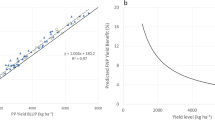Summary
Yields of F1 hybrids averaged 22% more than the mean of their heavier-yielding inbred parents, and the advantage of hybrids over composite populations varied from 3 to 18%, more in winter than spring beans.
From estimates of cost/benefit ratios that included the possibility of poor seedset on male steriles, on average 1 year in 10, it was concluded that hybrid seed might cost more than twice that of conventional varieties, but a 10% increase in yield on a 4t/ha crop would cover this extra cost of seed.
Thus, hybrids could still be the more profitable type of variety provided seed rates are low and yield levels high. It is therefore still worthwhile to pursue the goal of stable cytoplasmic male sterility (CMS) and/or a control of the rate of increase in revertants. Some methods are suggested whereby it might be possible to reduce revertants, improve pollination or exploit heterosis other than with CMS.
Similar content being viewed by others
References
Berthelem, P., 1986. Personal Communication.
Bond, D.A., 1964. Yield and components of yield in diallel crosses between inbred lines of winter beans (Vicia faba). Journal of Agricultural Science, Cambridge, 67, 325–336.
Bond, D.A., 1968. Hybrid field beans. NAAS Quarterly Review, 81, 1–6.
Bond, D.A., 1984. Behaviour of bees visiting a type of Vicia faba with closed flowers, Vème Symposium International sur la Pollinisation, Versailles 1983. Les Colloques de l'INRA, 21, 141–145.
Bond, D.A., 1989. A short review of research on male sterility and prospects for F1 hybrid varieties in field beans (Vicia faba L). Euphytica 41: 87–90.
Bond, D.A., J.M. Drayner, J.L. Fyfe & G. Toynbee-Clarke, 1964. Male sterility in field beans (Vicia faba L) I. A malesterile inherited as a Mendelian recessive. Journal of Agricultural Science, Cambridge, 63, 229–234.
Bond, D.A. & R.P. Hawkins, 1967. Behaviour of bees visiting male sterile field beans (Vicia faba). Journal of Agricultural Science, Cambridge, 68, 243–247.
Bond, D.A. & M. Pope, 1984. Effect of seed source on performance of faba bean varieties. In: P.D. Hebblethwaite, T.C.K. Dawkins, M.C. Heath & G. Lockwood, (Eds) Vicia faba: Agronomy, Physiology and Breeding. World Crops Vol 10, 127–134.
Duc, G., 1987. Personal Communication.
Duc, G., J. Le Guen, J. Picard & P. Berthelem, 1985b. Proposed use for a newly-discovered dominant male-sterile allele for breeding purposes in Vicia faba. FABIS, 12, 8–10.
Ebmeyer, E., 1986. Some results of the 1985 EEC Joint Field Bean Test. Vorträge für Pflanzenzüchtung, 11, 151–157.
Frauen, M., 1982. Personal Communication.
Poulsen, M.H., 1977. Obligate autogamy in Vicia faba L. Journal of agricultural Science, Cambridge, 88, 253–256.
Stoddard, F.L., 1986. Pollination and fertilization in commercial crops of field beans (Vicia faba L). Journal of Agricultural Science, Cambridge, 106, 89–97.
Wright, A.J., 1977. Inbreeding in synthetic varieties of field beans (Vicia faba L). Journal of Agricultural Science, Cambridge, 89, 495–501.
Author information
Authors and Affiliations
Rights and permissions
About this article
Cite this article
Bond, D.A. Prospects for commercialisation of F1 hybrid field beans Vicia faba L.. Euphytica 41, 81–86 (1989). https://doi.org/10.1007/BF00022415
Received:
Accepted:
Issue Date:
DOI: https://doi.org/10.1007/BF00022415




